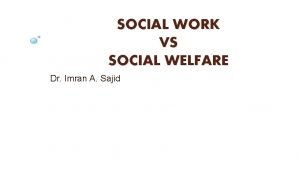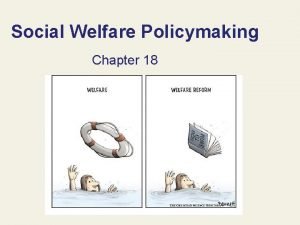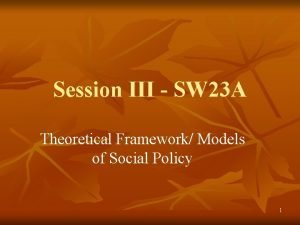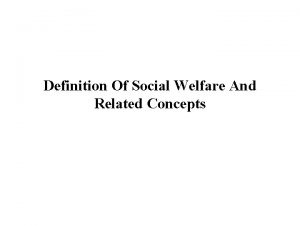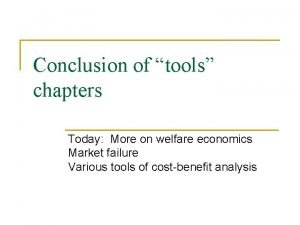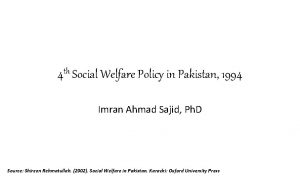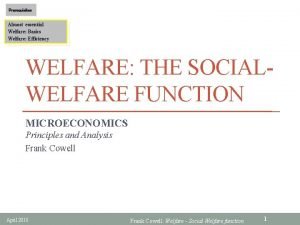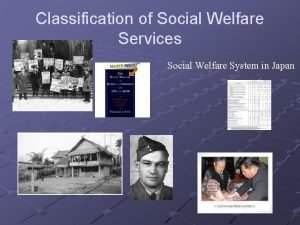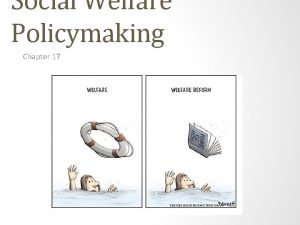Confronting Participation and Engagement Issues in Social Welfare











- Slides: 11

Confronting Participation and Engagement Issues in Social Welfare Interventions Kristen Slack, Ph. D University of Wisconsin-Madison April, 2017

Challenge Encouraging families to participate and engage in social welfare services when they are not asking for or seeking support.

Participation and Engagement Definitions “Participation refers to signs of client and program activity, such as enrollment, number and frequency of visits, and service completion” (Institute for Child and Family Well-Being, 2016). “Engagement reflects the quality of client attitudes toward, emotional investment in, and behaviors related to their services and service providers” (Institute for Child and Family Well-Being, 2016). Engagement is “the process* by which families and providers* develop and maintain a connection, while simultaneously demonstrating and communicating information, needs, attitudes, and values” (Mc. Ginty et al. , 2003, p. 489, as published in Staudt, 2007). *Emphasis added

Availability Awareness n io at cip rti Pa Contact En ga ge m en t Interest Intent to Enrollment Attendance Voice of Service Population Completion Access Continuum Impact Slack, K. S. (2017)

How do we think about non-participation? TYPE OF NON-PARTICIPATION • No outreach connection • Avoidant refusals: Ignoring letters and other outreach efforts. • Active refusals: “I don’t want or need this service”. • Passive refusals: “Sounds good, I’ll be there”, followed by a no-show • Reactive refusals: Initial attendance, followed by spotty or no further attendance. REASONS FOR NON-PARTICIPATION • Relevance and/or potency of marketing and outreach materials? • Competing demands, logistical hurdles? • Characteristics of individuals/families from intended service population? • Initial interaction with program staff? • Ongoing interactions with program staff or program site?

Integrated Theory of Participant Involvement (Mc. Curdy & Daro, 2001)

Engagement Framework (Staudt, 2007)

Select Research Findings on Prevention Services Participation and Engagement • Some research has shown that low-income status, racial or ethnic minority group status, and single parenthood are each associated with lower prevention service participation and engagement rates, but little research sheds light on why. • An evaluation of a Wisconsin home visiting program found that over half of those who did not enroll in services felt they didn’t need help or already had sufficient support (Institute for Child and Family Well-Being, 2016). • Use of monetary incentives to enhance program engagement has had mixed results: Some evidence that they enhance recruitment, but not ongoing participation or engagement (Dumas et al. , 2010; Heinrichs, 2006)

Practice Insights on Prevention Services Engagement Hierarchy of needs Motivation Service Relevance Other service options Competing demands Stigma Cultural relevance Logistical challenges Sellevaag, Palmer, and Brown, 2012

Questions for Discussion • How do agency staff effectively “sell” an intervention when the family is not initiating the request? • How do staff convince families to proactively address issues that might occur down the road? • How do staff move beyond generating interest to motivating participation and engagement? • How do we know if the intervention we offer is aligned with family needs? • How do we learn why people choose not to participate?

References • Dumas, J. E. , Begle, A. M. , French, B. , & Pearl, A. (2010). Effects of monetary incentives on engagement in the PACE parenting program. Journal of Clinical Child & Adolescent Psychology, 39(3), 302– 313. • Heinrichs, N. (2006). The effects of two different incentives on recruitment rates of fam- ilies into a prevention program. Journal of Primary Prevention, 27(4), 345– 365. • Institute for Child and Family Well-Being (2016). Issue Brief: Engaging Families in Home Visiting. https: //uwm. edu/icfw/engaging/. • Mc. Curdy, K. & Daro, D. (2001). Parent involvement in family support programs: An integrated theory. Family Relations, 50(2), 113 -121. • Mc. Ginty, K. L. , Diamond, J. M. , Brown, M. B. , & Mc. Cammon, S. L. (2003). Training child and adolescent psychiatrists and child mental health professionals for systems of care. In A. J. Pumariega & N. C. Winters (Eds. ), The handbook of child and adolescent systems of care: The new community psychiatry (pp. 487– 507). San Francisco, CA: Jossey-Bass. • Piper, K. A. (2016). Differential Response in Child Protection Services: A Comparison of Implementation and Child Safety Outcomes. (Doctoral Dissertation). Retrieved from Pro. Quest, (10010854). • Sellevaag, M. , Palmer, M. , & Brown, A. (2012). Rules of Engagement: Participant Recruitment and Retention. Office of Adolescent Health, U. S. Department of Health and Human Services. https: //www. hhs. gov/ash/oah/news/assets/rules_of_engagment_slides. pdf • Staudt, M. (2007). Treatment engagement with caregivers of at-risk children: Gaps inresearch and conceptualization. J of Child & Family Studies, 16, 183 -196.
 Partial participation
Partial participation Social welfare vs social work
Social welfare vs social work Ethics and social welfare
Ethics and social welfare Examples of social welfare programs
Examples of social welfare programs Industrial achievement performance model
Industrial achievement performance model Remedial approach in social work
Remedial approach in social work What is social welfare
What is social welfare Social welfare models
Social welfare models Conclusion of welfare economics
Conclusion of welfare economics 2nd social welfare policy in pakistan
2nd social welfare policy in pakistan Tools of normative analysis
Tools of normative analysis Social welfare in colombia
Social welfare in colombia

